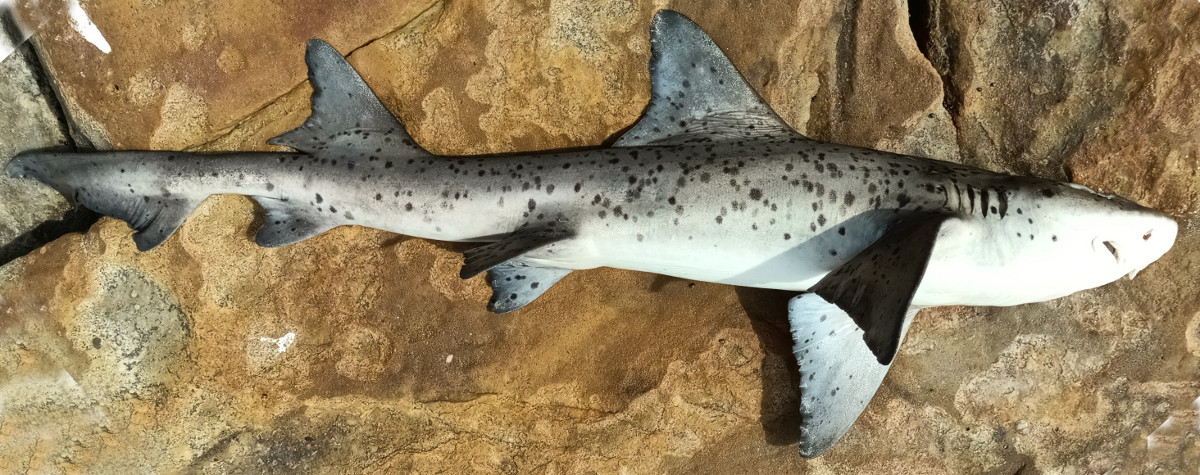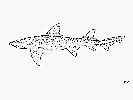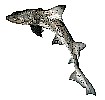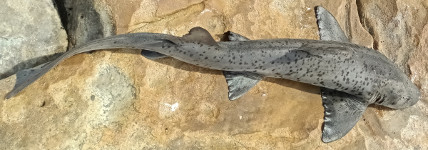Triakis megalopterus
(Smith, 1839)
Sharptooth houndshark
Classification: Elasmobranchii Carcharhiniformes Triakidae
Reference of the original description
Pisces. Illustrations of the zoology of South Africa. Smith, Elder, London, vol. 4, 77 pp., not numbered, pls 1–31
Pisces. Illustrations of the zoology of South Africa. Smith, Elder, London, vol. 4, 77 pp., not numbered, pls 1–31
Image of the original description
.jpg)
Triakis megalopterus (Smith, 1839)
.jpg)
Triakis megalopterus (Smith, 1839)
Synonyms / new combinations and misspellings
Mustelus megalopterus, Mustelus natalensis, Mustelus nigropunctatus, Triakis megaloptera, Triakis natalensis, Triakis (Cazon) megalopterus
Mustelus megalopterus, Mustelus natalensis, Mustelus nigropunctatus, Triakis megaloptera, Triakis natalensis, Triakis (Cazon) megalopterus
Types
Triakis megalopterus
Mustelus natalensis
Holotype: NMW: lost? not found in 2011;
Mustelus nigropunctatus
Holotype: SAIAB: 424; Paratype: SAIAB: not researched;
Triakis megalopterus
Mustelus natalensis
Holotype: NMW: lost? not found in 2011;
Mustelus nigropunctatus
Holotype: SAIAB: 424; Paratype: SAIAB: not researched;
Description :
Citation: Triakis megalopterus (Smith, 1839): In: Database of modern sharks, rays and chimaeras, www.shark-references.com, World Wide Web electronic publication, Version 12/2025
Please send your images of "Triakis megalopterus" to info@shark-references.com

Triakis megalopterus (Smith, 1839); Cape Francis, South Africa, 20.04.2025 © www.shark-references.com

Triakis megalopterus (Smith, 1839); Cape Francis, South Africa, 20.04.2025 © www.shark-references.com
Common names
 Tollo dentudo,
Tollo dentudo,  Virli dentu,
Virli dentu,  Sharptooth houndshark,
Sharptooth houndshark,  Spotted gulley shark,
Spotted gulley shark,  Spotted gully shark,
Spotted gully shark,  Spotted gullyshark,
Spotted gullyshark,  Spotty
Spotty
 Tollo dentudo,
Tollo dentudo,  Virli dentu,
Virli dentu,  Sharptooth houndshark,
Sharptooth houndshark,  Spotted gulley shark,
Spotted gulley shark,  Spotted gully shark,
Spotted gully shark,  Spotted gullyshark,
Spotted gullyshark,  Spotty
Spotty
Short Description
Original diagnosis after Compagno, 1984 [517]: Field Marks: A very stout houndshark with a short, broadly rounded snout, lobate anterior nasal flaps that do not reach the mouth and are far separated from each other, long upper labial furrows that reach the lower symphysis of the mouth, semimolariform teeth with straight erect cusps and cusplets little-developed or absent, broad large fins with the pectorals broadly falcate and the first dorsal fin with a vertical posterior margin, and often black spots.
Diagnostic Features: Teeth with strong erect cusps on at least. the middle two-thirds of the dental band but often not well developed on more distal teeth, cusplets low or absent on almost all teeth, semimolariform but not bladelike. First dorsal fin with abruptly vertical posterior margin; pectoral fins broadly falcate in adults. Total vertebral counts 162 to 166. Body with a few to numerous small black spots, few or absent in young, often numerous in adults although plain adults have been recorded
Original diagnosis after Compagno, 1984 [517]: Field Marks: A very stout houndshark with a short, broadly rounded snout, lobate anterior nasal flaps that do not reach the mouth and are far separated from each other, long upper labial furrows that reach the lower symphysis of the mouth, semimolariform teeth with straight erect cusps and cusplets little-developed or absent, broad large fins with the pectorals broadly falcate and the first dorsal fin with a vertical posterior margin, and often black spots.
Diagnostic Features: Teeth with strong erect cusps on at least. the middle two-thirds of the dental band but often not well developed on more distal teeth, cusplets low or absent on almost all teeth, semimolariform but not bladelike. First dorsal fin with abruptly vertical posterior margin; pectoral fins broadly falcate in adults. Total vertebral counts 162 to 166. Body with a few to numerous small black spots, few or absent in young, often numerous in adults although plain adults have been recorded
Human uses
fisheries: minor commercial; gamefish: yes; aquarium: public aquariums; price category: high; price reliability: very questionable: based on ex-vessel price for species in this family
fisheries: minor commercial; gamefish: yes; aquarium: public aquariums; price category: high; price reliability: very questionable: based on ex-vessel price for species in this family
Biology
Ovoviviparous, embryos feed solely on yolk [733], with 6 to 12 young in a litter [517]. 30-32 cm at birth [517]. Occurs off sandy beaches, rocky shores and in shallow bays [536]. Feeds on crabs, lobsters, bony fish and small sharks [536]. Forms schools in summer [517]. Hardy and keeps well in captivity [517]. Commonly caught by rock and surf sports anglers but not eaten much [517]. Meat is dried into shark "quot;biltong"quot; or jerky which commands a relatively high price [517].
Ovoviviparous, embryos feed solely on yolk [733], with 6 to 12 young in a litter [517]. 30-32 cm at birth [517]. Occurs off sandy beaches, rocky shores and in shallow bays [536]. Feeds on crabs, lobsters, bony fish and small sharks [536]. Forms schools in summer [517]. Hardy and keeps well in captivity [517]. Commonly caught by rock and surf sports anglers but not eaten much [517]. Meat is dried into shark "quot;biltong"quot; or jerky which commands a relatively high price [517].
Size / Weight / Age
142 cm TL (male/unsexed; [517]); 174 cm TL (female); max. published weight: 20.0 kg [20040]
142 cm TL (male/unsexed; [517]); 174 cm TL (female); max. published weight: 20.0 kg [20040]
Remarks
shark-references Species-ID=7246;
shark-references Species-ID=7246;



















